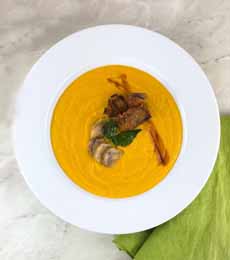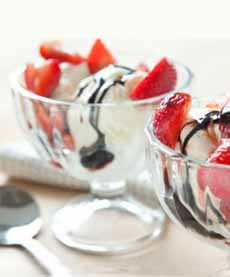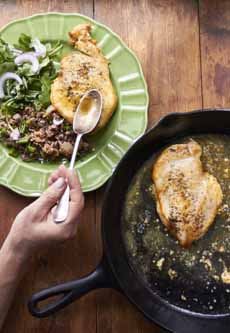TIP OF THE DAY: Uses For Balsamic Vinegar, Beyond Vinaigrette
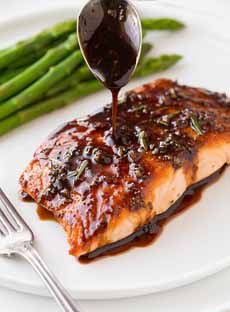 [1] Salmon with balsamic glaze. Here’s the recipe from courtesy Cooking Classy.
|
Balsamic is our vinegar of choice with salad. We have 10 other vinegars, but when we want rich flavor and low acidity, we always reach for the balsamic. We currently have different ages of traditionale balsamic, condimento balsamic, plus industriale flavored balsamics in blackberry, chocolate, fig and pomegranate (there are numerous other flavors to be had).
With so much balsamic on the shelf, we’re always looking for new ways to use them. The latest is reduced chocolate balsamic syrup on vanilla and chocolate ice cream, but here are classic uses: Use balsamic vinegar as you would use wine, to finish dishes or reduce into glazes and sauces. If you reduce balsamic vinegar into a syrup, you get balsamic glaze, also called creme balsamica (balsamic cream). It’s a luscious condiment for drizzling over savory or sweet dishes. With its complex flavors—sweet, sour, fruity—at its simplest, it can enhance anything grilled or roasted, including panini and other grilled sandwiches. Even nachos! Balsamic syrup is a dessert syrup, too: on ice cream, pound cake, puddings and more. Here are dozens of ways to use balsamic glaze, and a simple recipe. Braising involves searing the food over high heat, then stewing it in a liquid (in a covered pot at a lower temperature). Whether you’re braising proteins or vegetables, add a tablespoon of balsamic to the braising liquid. It creates a rich layer of flavor with a hint of sweetness. It waves a magic braised fennel, braised radishes and other veggies. It also waves a magic wand over caramelized onions and mushroom ragout. Balsamic vinegar is a known tenderizer. It imparts a rich, sweet flavor to meat and a cook’s “secret” to tenderize meats. It’s also a star with portabella mushrooms and tofu. You can make as simple a marinade as you like. We like this combination: The simplest sauce is made from the pan juices that result from sautéing a protein: fish, meat or poultry (photo #4). When you deglaze the pan to make the sauce, add a splash of balsamic to the wine, broth or other liquid. Many soups, including gazpacho, get a touch of glamour from balsamic vinegar. Stir a a half or whole teaspoon per serving at the end of cooking. It adds brightness and a sophisticated layer of flavor. Or, splash or drizzle some balsamic on top of a thick purée (photo #2). Tell your inner mixologist to get out the balsamic vinegar and add some (or more) sophistication to drinks. You can add balsamic vinegar to soft drinks and club soda to make shrubs. Or, layer more flavor into cocktails. This works best with bourbon and whiskey, which have heavier flavors than white spirits and are more adaptable to the balsamic. |
|
|
RECIPE: BALSAMIC NEGRONI COCKTAIL This Pomegranate Negroni from Sid Wainer & Sons (photo #5) will have guests wondering what the “special ingredient” is. You can use any flavor of balsamic, or even plain balsamic; but we like fall flavors here, such as fig, ginger, pear and pomegranate balsamic. Ingredients Per Drink |
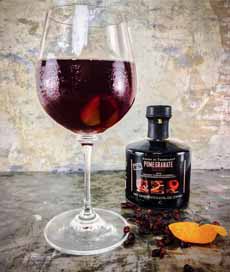
[5] A Pomegranate Negroni: Just add pomegranate balsamic. The recipe is below (photo courtesy Sid Wainer & Sons). |
|
|
Preparation 1. COMBINE the ingredients including ice in a shaker. Shake and pour into a chilled glass. 2. GARNISH with the orange peel and optional pomegranate arils. The Negroni is one of the classic cocktails of the 20th century, dating to 1919. As the story goes, the cocktail was invented at the Bar Cassoni* in Florence, Italy by bartender Fosco Scarselli. He created it for a regular patron, Count Camillo Negroni, who had asked for an Americano cocktail strengthened with a dash of gin instead of the usual soda water. Scarselli switched the garnish of the Americano from lemon peel to orange, and presented his client with a “Negroni.” The cocktail took off, and the Count’s family quickly founded Negroni Antica Distilleria in Treviso, producing Antico Negroni, a ready-made version of the drink. But the cocktail was unknown in the U.S. until 1947 when Orson Welles, working in Rome, wrote about it, creating a rush to try it. *Bar Cassoni became Caffè Casoni and is now called Caffè Cavalli. |
||
